Curtains are essential elements in home decor, offering privacy, light control, and style. This article explores 27 types of curtains, detailing their unique features and best uses. From sheer to blackout, rod pocket to grommet, understanding these curtain varieties will help you choose the perfect window treatments for every room in your home.
27 Types of Curtains
The following is a detailed introduction to the main 27 types of curtains
1. Sheer curtains
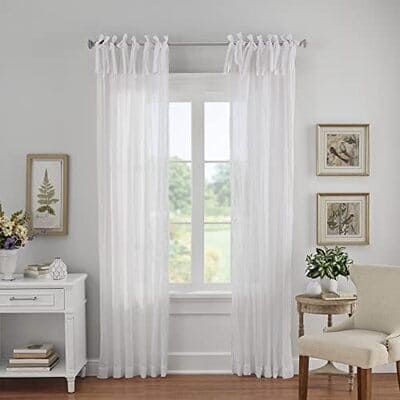
Sheer curtains are lightweight, translucent window coverings made from thin fabrics such as voile, chiffon, or organza. They allow natural light to filter through while providing a minimal level of privacy.
Features:
- Translucent fabric
- Light-filtering properties
- Minimal privacy
- Available in various colors and patterns
- Often used in combination with heavier curtains
Best Uses:
- Living rooms and dining areas for a soft, airy ambiance
- Bedrooms as an additional layer behind blackout curtains
- Sunrooms or areas where natural light is desired
- Spaces requiring a decorative touch without full coverage
2. Blackout/Blockout curtains
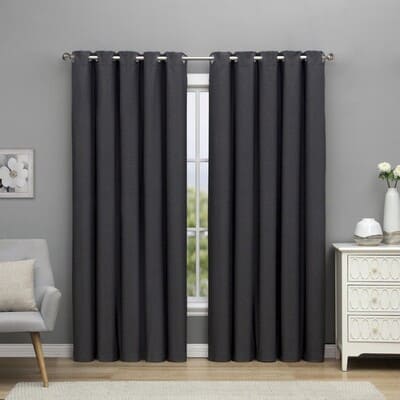
Blackout curtains are thick, opaque window treatments designed to block out light completely. They are typically made from tightly woven fabrics or have a special lining to prevent light penetration.
Features:
- Complete light blockage
- Insulating properties
- Noise reduction capabilities
- Available in various styles and colors
- Often made with multiple layers of fabric
Best Uses:
- Bedrooms for improved sleep quality
- Home theaters or media rooms
- Shift workers' homes for daytime sleep
- Nurseries or children's rooms for nap times
- Energy efficiency in rooms with direct sunlight
3. Single-panel curtains
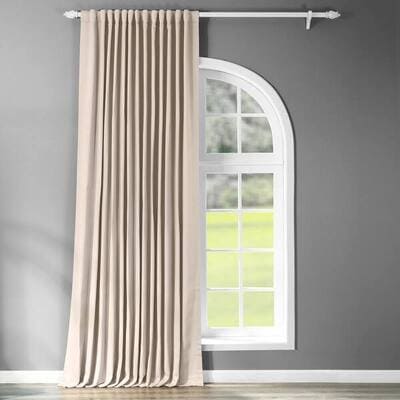
Single-panel curtains consist of one large piece of fabric that covers the entire window. They are typically wider than the window and can be pulled to one side when opened.
Features:
- One continuous piece of fabric
- Simple, streamlined appearance
- Easy to open and close
- Can be custom-sized for any window
- Often used with decorative tiebacks
Best Uses:
- Narrow windows or small spaces
- Modern or minimalist interior designs
- French doors or sliding glass doors
- Creating a focal point in a room
- Rooms where a sleek, uncluttered look is desired
4. Double-panel curtains
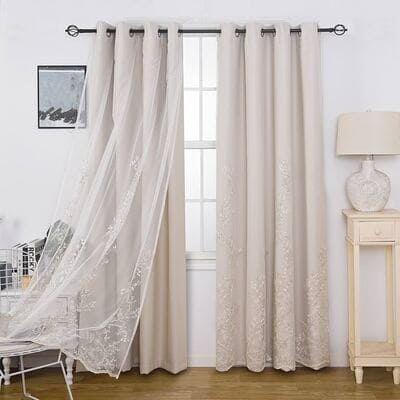
Double-panel curtains, also known as pair curtains, consist of two separate panels that meet in the middle when closed. They are typically hung on a single rod and can be opened by pulling each panel to the sides.
Features:
- Two separate fabric panels
- Versatile opening options
- Fuller appearance when closed
- Can be styled in various ways (e.g., tied back, pleated)
- Often used with curtain holdbacks
Best Uses:
- Wide windows or sliding doors
- Traditional or formal room designs
- Creating symmetry in a space
- Allowing partial light and visibility when one panel is open
- Rooms where a more substantial window treatment is desired
5. Insulated/Thermal curtains
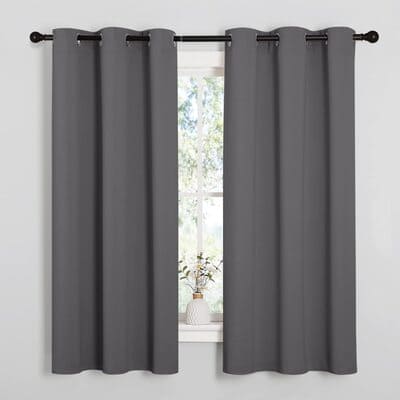
Insulated or thermal curtains are designed to regulate room temperature by preventing heat loss in winter and heat gain in summer. They typically feature multiple layers of fabric, including a thermal lining.
Features:
- Temperature regulation properties
- Energy-saving benefits
- Often have noise-reducing qualities
- Available in various styles and thicknesses
- May include vapor barriers to prevent condensation
Best Uses:
- Rooms with drafty windows or poor insulation
- Reducing energy costs in extreme climates
- Bedrooms for improved sleep comfort
- Living areas to maintain consistent temperatures
- Sunrooms or areas with large windows exposed to direct sunlight
6. Acoustic/Soundproof curtains

Acoustic or soundproof curtains are designed to reduce noise transmission through windows. They are made with dense, heavy materials and often feature multiple layers to absorb and block sound waves.
Features:
- Noise reduction capabilities
- Dense, heavy fabric construction
- Often include foam or mass-loaded vinyl layers
- May have thermal insulation properties
- Available in various styles and colors
Best Uses:
- Urban apartments or homes near busy streets
- Home offices or study areas
- Bedrooms for improved sleep quality
- Music rooms or home studios
- Conference rooms or spaces requiring privacy
7. Grommet/Eyelet curtains
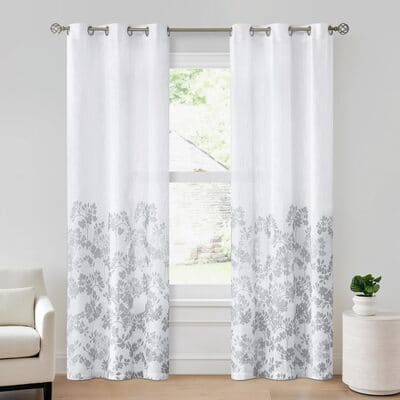
Grommet or eyelet curtains feature large metal rings embedded in the top edge of the fabric. These rings slide directly onto a curtain rod, creating a pleated effect when hung.
Features:
- Metal rings (grommets) at the top of the panel
- Easy to open and close
- Create uniform, evenly spaced pleats
- Modern, sleek appearance
- Available in various fabrics and colors
Best Uses:
- Contemporary or modern interiors
- Large windows or sliding doors
- Spaces where easy operation is desired
- Rooms with a casual or relaxed atmosphere
- Areas where a clean, streamlined look is preferred
8. Rod pocket curtains
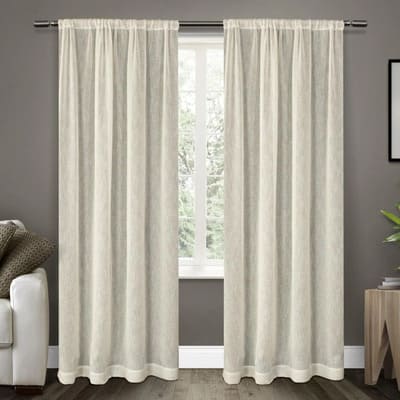
Rod pocket curtains have a sewn-in pocket or casing at the top that slides directly onto a curtain rod. This creates a gathered, slightly ruffled appearance at the top of the curtain.
Features:
- Hidden rod for a clean look
- Gathered fullness at the top
- Easy to install and remove
- Available in various fabrics and styles
- Often used with decorative rods
Best Uses:
- Traditional or country-style interiors
- Bedrooms and living rooms
- Windows where a soft, casual look is desired
- Spaces where frequent opening/closing is not required
- Areas where the focus should be on the fabric rather than hardware
9. Tab top curtains
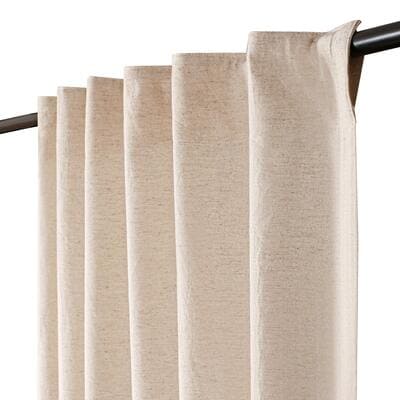
Tab top curtains feature fabric loops or "tabs" sewn into the top edge of the panel. These tabs slide onto a curtain rod, creating a casual, relaxed appearance with visible hardware.
Features:
- Fabric loops at the top for hanging
- Casual, relaxed look
- Easy to install and remove
- Create even spaces between pleats
- Available in various fabrics and styles
Best Uses:
- Casual or rustic interiors
- Kitchens and dining areas
- Sunrooms or porches
- Children's rooms or playrooms
- Spaces where a laid-back, informal atmosphere is desired
10. Tie top curtains
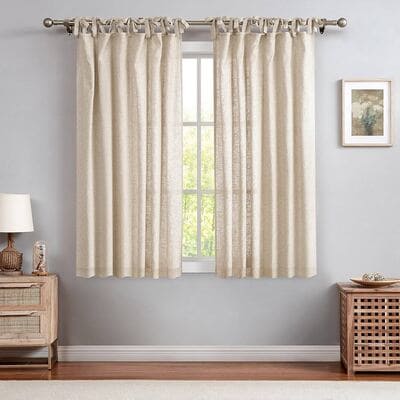
Tie top curtains have long fabric ties sewn into the top edge of the panel. These ties are used to attach the curtain to the rod, creating a soft, gathered look with a decorative bow at each tie point.
Features:
- Fabric ties for attaching to the rod
- Adjustable fullness and height
- Romantic, whimsical appearance
- Easy to install and remove
- Often made with lightweight fabrics
Best Uses:
- Cottage or shabby chic interiors
- Girls' bedrooms or nurseries
- Beach houses or vacation homes
- Spaces where a soft, feminine look is desired
- Areas where frequent height adjustments may be needed
11. Pinch pleat curtains
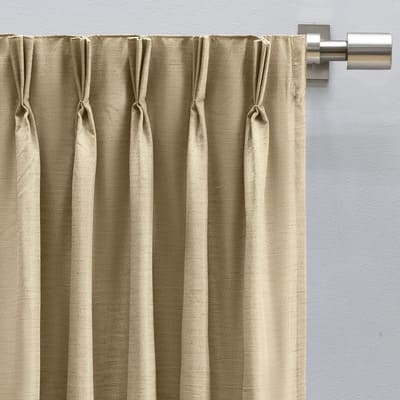
Pinch pleat curtains feature evenly spaced, sewn pleats at the top of the panel. These pleats are created by pinching and sewing several inches of fabric together, forming a tailored, structured look.
Features:
- Tailored, elegant appearance
- Evenly spaced pleats for controlled fullness
- Available in various pleat styles (e.g., two-finger, three-finger)
- Often lined for added structure
- Suitable for both formal and casual settings
Best Uses:
- Traditional or formal living rooms and dining rooms
- Master bedrooms
- Home offices or studies
- Spaces where a refined, classic look is desired
- Rooms with high ceilings or large windows
12. Box pleat curtains
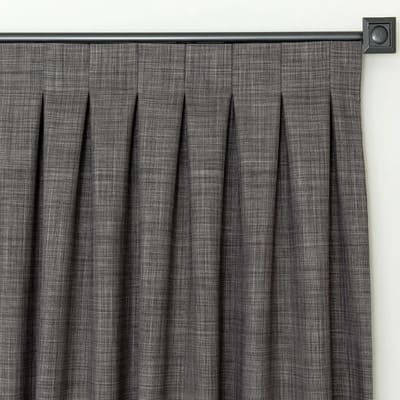
Box pleat curtains, also known as inverted pleat curtains, feature deep, evenly spaced pleats that are folded inward at the top of the panel. This creates a structured, tailored appearance with a clean line along the top.
Features:
- Crisp, tailored look
- Uniform pleats across the curtain top
- Suitable for both light and heavy fabrics
- Often lined for added structure
- Creates a formal, elegant appearance
Best Uses:
- Formal living rooms and dining rooms
- Traditional or transitional style interiors
- Rooms with high ceilings
- Spaces where a structured, sophisticated look is desired
- Areas where a clean, streamlined top edge is preferred
13. Goblet pleat curtains
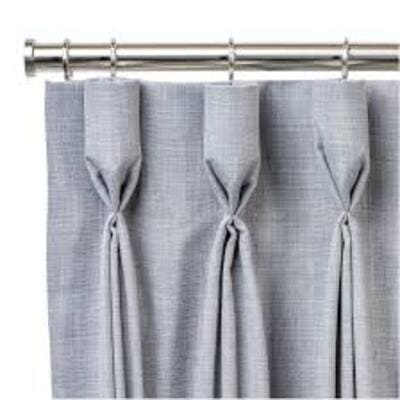
Goblet pleat curtains feature pleats that are shaped to resemble a wine goblet or chalice at the top of the panel. This creates a highly decorative and formal appearance.
Features:
- Distinctive goblet-shaped pleats
- Highly decorative and formal look
- Often require interlining for structure
- Best suited for floor-length curtains
- Typically used with curtain poles rather than tracks
Best Uses:
- Formal dining rooms and living rooms
- Grand entryways or foyers
- Master bedrooms in traditional homes
- Spaces where a luxurious, opulent look is desired
- Rooms with high ceilings or large windows
14. Pencil pleat curtains
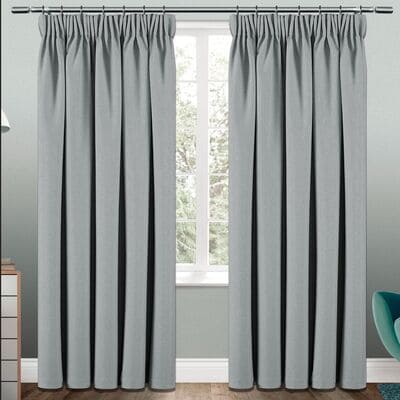
Pencil pleat curtains feature closely gathered pleats at the top of the panel, resembling a row of pencils standing side by side. This versatile heading style can be adjusted to create varying degrees of fullness.
Features:
- Versatile and adaptable style
- Can be used with both tracks and poles
- Adjustable fullness
- Suitable for light to medium-weight fabrics
- Easy to hang and remove
Best Uses:
- Bedrooms and living rooms
- Children's rooms
- Rental properties due to their adaptability
- Spaces where frequent changing of curtains is desired
- Rooms with various window sizes and shapes
15. Wave fold/Ripplefold curtains
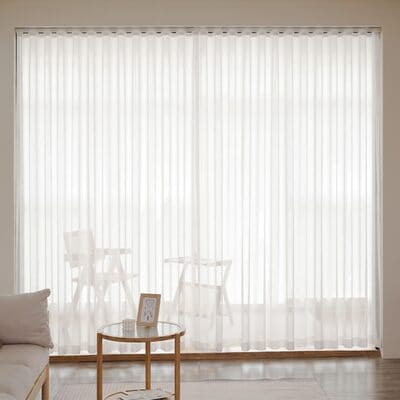
Wave fold or Ripplefold curtains feature a smooth, continuous S-shaped curve along the top of the panel. This creates a modern, streamlined look with soft, undulating folds when the curtains are closed.
Features:
- Smooth, continuous wave pattern
- Modern and minimalist appearance
- Requires less fabric than traditional pleated styles
- Allows for easy operation and stacking
- Often used with specialized tracking systems
Best Uses:
- Contemporary or modern interiors
- Large windows or sliding glass doors
- Offices or commercial spaces
- Rooms where a clean, uncluttered look is desired
- Areas where maximizing natural light is important
16. Swag curtains
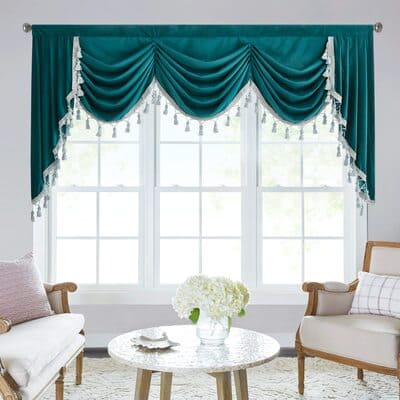
Swag curtains, also known as scarf curtains, feature fabric draped elegantly over a rod or hooks to create a soft, curved shape. They add a decorative touch to windows without fully covering them.
Features:
- Graceful, draped appearance
- Often used as a valance or top treatment
- Can be layered with other curtain types
- Available in various fabrics and lengths
- Typically hung using decorative hooks or a rod
Best Uses:
- Formal living rooms and dining rooms
- Master bedrooms for a romantic touch
- Bay windows or picture windows
- Spaces where a decorative accent is desired
- Areas where full coverage is not necessary
17. Tier curtains

Tier curtains consist of two or more separate curtain panels hung at different levels on the same window. They provide flexibility in light control and privacy.
Features:
- Multiple panels at different heights
- Often used in combination with a valance
- Allows for customizable coverage
- Usually made of lightweight fabrics
- Can be adjusted independently
Best Uses:
- Kitchens and breakfast nooks
- Bathrooms for privacy with light
- Sunrooms or porches
- Children's rooms for versatility
- Areas where partial window coverage is desired
18. Cafe curtains
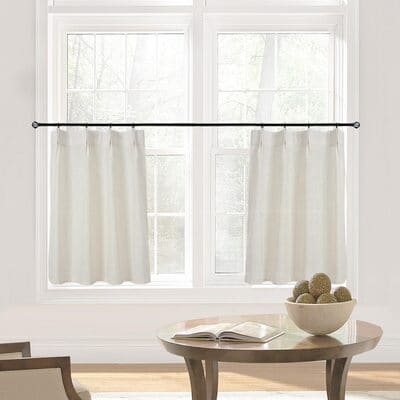
Cafe curtains are short curtains that cover only the lower portion of a window, typically hanging from a rod installed at the window's midpoint. They provide privacy while still allowing natural light to enter through the upper part of the window.
Features:
- Cover only the bottom half of the window
- Often used with a valance for the top portion
- Provide privacy without blocking all light
- Usually made of lightweight, washable fabrics
- Easy to install and remove
Best Uses:
- Kitchens and dining areas
- Bathrooms for privacy
- Home offices or studies
- Ground floor windows where privacy is needed
- Spaces where a casual, relaxed look is desired
19. Apron curtains

Apron curtains, also known as half-length curtains, extend a few inches below the window sill but do not reach the floor. They offer a balance between window sill curtains and full-length drapes.
Features:
- Hang about 4 inches below the window sill
- Provide a casual, relaxed look
- Allow for furniture placement under windows
- Often used in less formal settings
- Easy to open and close
Best Uses:
- Kitchens with counters under windows
- Rooms with radiators or air conditioners below windows
- Casual living spaces or family rooms
- Children's bedrooms
- Areas where full-length curtains might be impractical
20. Window sill curtains

Window sill curtains are short curtains that end right at or slightly above the window sill. They provide a clean, tailored look and are practical for certain types of windows and room configurations.
Features:
- End at or just above the window sill
- Provide a neat, tidy appearance
- Allow for easy window access
- Often used in more casual or functional spaces
- Suitable for windows above furniture or fixtures
Best Uses:
- Kitchens, especially over sinks
- Bathrooms for small windows
- Laundry rooms or utility areas
- Windows above radiators or air conditioning units
- Spaces where longer curtains might interfere with functionality
21. Decorative curtains
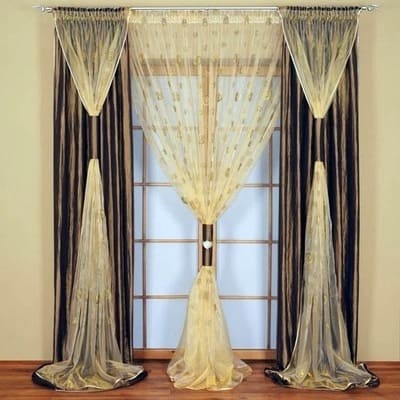
Decorative curtains are primarily designed for aesthetic purposes rather than functionality. They often feature elaborate patterns, textures, or embellishments to enhance the room's decor.
Features:
- Emphasis on visual appeal
- May include embroidery, beading, or other embellishments
- Often made from luxurious fabrics
- May not provide full coverage or light control
- Can be used alone or layered with functional curtains
Best Uses:
- Formal living rooms or dining rooms
- Master bedrooms for added elegance
- Home theaters or entertainment spaces
- Areas where window treatment is purely decorative
- Spaces where a statement piece is desired
22. Valance curtains
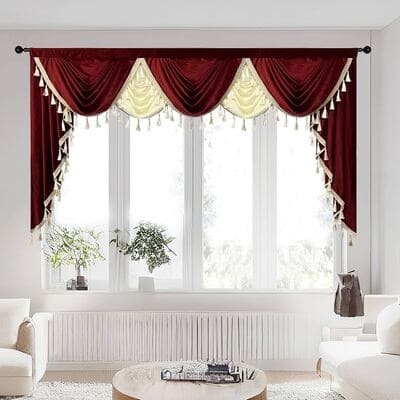
Valance curtains are short decorative panels that cover only the top portion of a window. They can be used alone or in combination with other curtain types to add a finishing touch to window treatments.
Features:
- Cover only the top of the window
- Available in various styles (e.g., box pleated, scalloped, swag)
- Can be mounted on a rod or board
- Often used to conceal curtain hardware
- Add a decorative element without full window coverage
Best Uses:
- Kitchens and bathrooms
- Living rooms and bedrooms as a top treatment
- Paired with blinds or shades for a layered look
- Spaces where a decorative accent is desired
- Areas where full curtains might be impractical
23. Priscilla curtains

Priscilla curtains, also known as Priscilla pairs, feature two sheer panels that cross over each other and are tied back at the sides. They create a romantic, cottage-style look.
Features:
- Crossed panels with ruffled edges
- Usually made of sheer or semi-sheer fabric
- Typically white or off-white in color
- Often include matching tiebacks
- Create a soft, feminine appearance
Best Uses:
- Cottage-style or country homes
- Girls' bedrooms or nurseries
- Guest rooms for a welcoming touch
- Sunrooms or breakfast nooks
- Spaces where a romantic, vintage look is desired
24. Balloon curtains
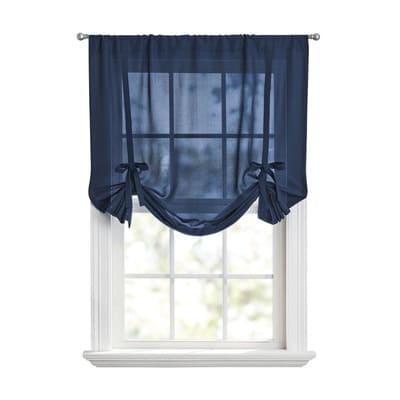
Balloon curtains feature fabric that is gathered and puffed out at the bottom, creating a rounded, balloon-like shape. They add a dramatic and romantic touch to windows.
Features:
- Billowing, puffy bottom
- Fixed in a semi-raised position
- Often made with lightweight fabrics
- Can be adjusted for varying levels of fullness
- Usually lined to maintain shape
Best Uses:
- Formal dining rooms or living rooms
- Master bedrooms for a luxurious touch
- Victorian or traditional style homes
- Spaces where a dramatic window treatment is desired
- Areas with high ceilings to balance proportions
25. Roman shades
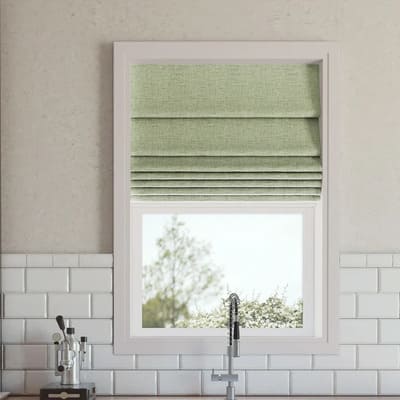
Roman shades are a type of window covering that folds up into neat horizontal pleats when raised. They provide a clean, tailored look when lowered and a streamlined appearance when raised.
Features:
- Flat fabric panels that fold when raised
- Available in various styles (e.g., flat, hobbled, relaxed)
- Can be made from a wide range of fabrics
- Offer adjustable light control and privacy
- Often feature cordless or motorized operation
Best Uses:
- Modern or traditional interiors
- Kitchens and bathrooms
- Home offices or studies
- Bedrooms for light control
- Spaces where a sleek window treatment is desired
26. Sliding panel curtains

Sliding panel curtains, also known as panel track blinds, consist of large fabric panels that slide along a track system. They are ideal for large windows or as room dividers.
Features:
- Large, flat panels that slide horizontally
- Stackable when fully opened
- Available in various fabrics and opacities
- Often used for patio doors or large windows
- Can be motorized for easy operation
Best Uses:
- Sliding glass doors or French doors
- Large picture windows
- As room dividers in open floor plans
- Modern or contemporary interiors
- Spaces requiring flexible light control and privacy
27. Outdoor curtains

Outdoor curtains are designed to withstand outdoor elements while providing privacy and shade for patios, decks, or porches. They are made from weather-resistant fabrics.
Features:
- Weather-resistant and fade-resistant fabrics
- Often treated for mold and mildew resistance
- Heavier weight to withstand wind
- Available in various styles and colors
- May include UV protection
Best Uses:
- Patios and decks for privacy
- Outdoor dining areas for shade
- Gazebos or pergolas
- Poolside cabanas
- Balconies in apartments or condos

